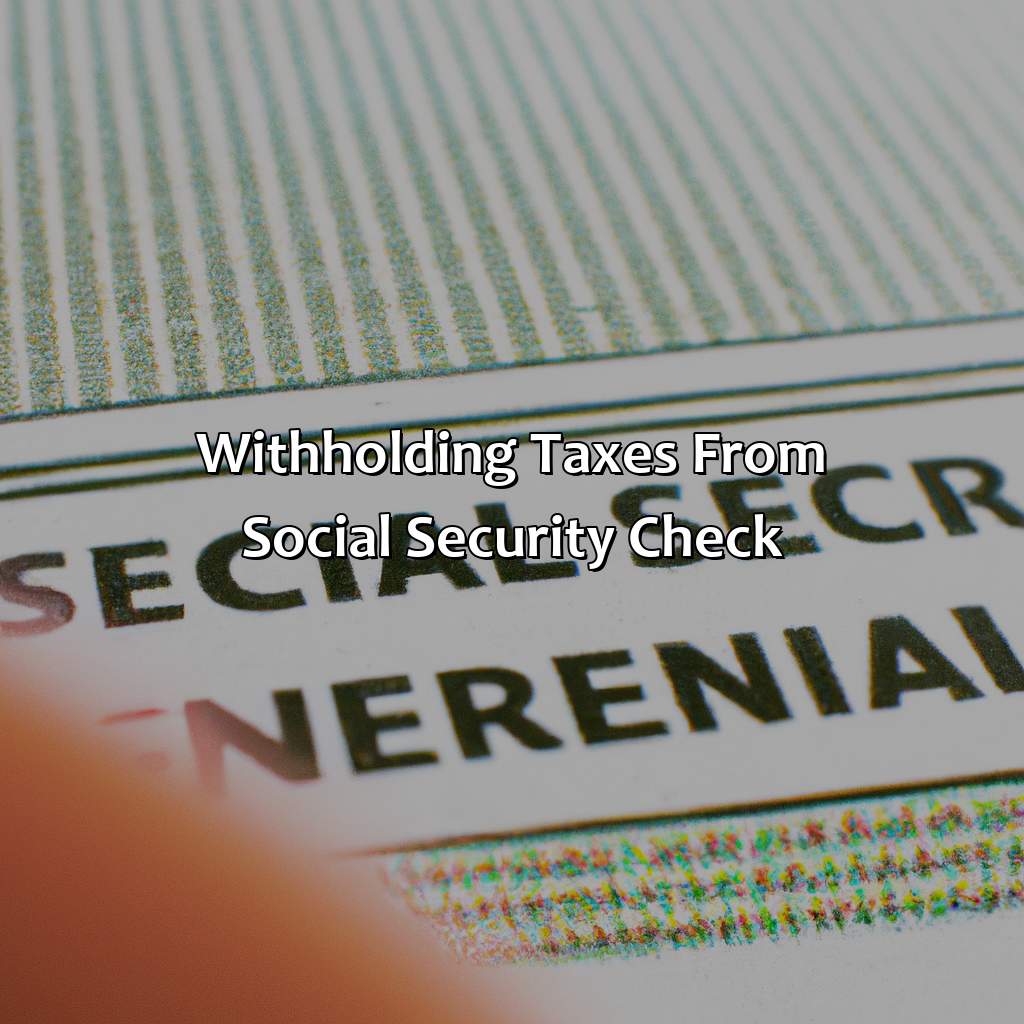How Do I Withhold Taxes From My Social Security Check?
Key Takeaway:
- Eligibility for tax withholding: If you receive a Social Security check, you can request to have federal taxes withheld from your payment if you expect to owe taxes at the end of the year. You must meet certain criteria to be eligible for tax withholding, such as being a U.S. citizen or resident alien and having a taxable income.
- How to request tax withholding: To request tax withholding from your Social Security check, you can fill out a Form W-4V and submit it to the Social Security Administration. You can choose to withhold a flat rate of 7%, 10%, 12%, or 22% of your monthly benefit amount.
- Important considerations: It’s important to understand the taxation of Social Security benefits and explore alternative tax payment options to avoid underpayment penalties. It’s also recommended to speak with a tax professional for personalized advice on tax withholding and payment strategies.
Are you worried about how to withhold taxes from your social security check? You’re not alone. Get the tax information you need to protect your finances and understand your tax obligations. This article will show you the steps you need to take.
Withholding Taxes from Social Security Check
You can rely on simple, effective solutions for withholding taxes from your social security check! This section covers: eligibility for tax withholding, requesting tax withholding, and withholding rates & options. So, check it out!

Image credits: retiregenz.com by Harry Woodhock
Eligibility for Tax Withholding
If you are eligible for tax withholding, you can opt to have federal taxes withheld from your Social Security benefits. Eligibility requires that the recipient is in receipt of Social Security benefits as well as having a taxable income or combined income that exceeds a certain threshold. The IRS determines the threshold limits annually and will only apply withholding taxes when these limits have been crossed. A recipient of Social Security benefits can choose between 7%, 10%, 12% or 22% withholding rates of their benefit amount to withhold for taxes.
Moreover, it’s important to note that not all states impose state taxes on Social Security income, so ensure that you are aware of your state’s specific tax laws before choosing to withhold state taxes.
In 2021, the IRS announced that beneficiaries who filed Form SSA-1099 and Form RRB-1099 with an address outside of the US would receive a maximum foreign social security equivalent exemption amount of $100,000 if they meet certain conditions.
(Source: www.ssa.gov)
Because nobody wants the IRS to come knocking on their door like a particularly unwanted guest.
How to Request Tax Withholding
To ensure tax is withheld from your social security check, you can request tax withholding from the Social Security Administration. Follow these six steps to request tax withholding:
- Log in to your My Social Security account or create one if you don’t have one yet.
- Click on “Re
- Choose “Start or Change Withholding.”
- Enter the percentage of your monthly benefit that you want withheld for taxes.
- Save your changes.
- Print out the form and mail it to your local Social Security Administration office.
Figuring out the withholding rates for your social security check is like trying to solve a Rubik’s cube, except with less colors and more frustration.
Withholding Rates and Options
For individuals looking to withhold taxes from their Social Security checks, knowing the different options and rates beforehand is crucial. Here are the latest withholding rates and options:
| Withholding Status | Withholding Rate |
| Single or Married Filing Separately: $25,000 or less | 0% |
|
Single: between $25,000-$34,000; Married Filing Jointly: between $32,000-$44,000 |
Up to 50% of benefits |
| Married Filing Separately: Greater than $44,000; Other Filers: Greater $34,000 |
Up to 85% of benefits |
It’s crucial to note that those wanting more federal tax withheld could request voluntary tax withholds on their baby blue envelopes sent each month by Social Security.
Interestingly enough, the current law requiring American workers to pay into Social Security began in August of 1935; however, retirement benefits wouldn’t begin until January of 1940.
Before you go withholding taxes from your social security check, consider this: the government always gets their cut, even if it’s just a slice of your retirement pie.
Important Considerations
Let’s explore two key areas for considering taxation on your social security check. We’ll look at the taxation of benefits, as well as alternative options for paying taxes. Gather your info and consider your options for better tax outcomes!

Image credits: retiregenz.com by Harry Duncun
Taxation of Social Security Benefits
Social Security Benefits are often taxable, and the taxation rate depends on various factors. The IRS follows a tiered system to determine the amount to be taxed based on an individual’s provisional income. This is an important consideration, as failing to withhold taxes from your Social Security check can result in an unexpected tax bill at the end of the year.
It’s worth noting that not everyone needs to pay income tax on their Social Security benefits. For instance, if Social Security is your only source of income, you won’t have to pay federal taxes on it. However, if you earn additional income from other sources like retirement savings accounts or investments, part of your Social Security benefits may be subject to taxation.
Given these considerations, it’s crucial to understand how much of your Social Security benefits will be taxed and prepare accordingly. This may involve adjusting your withholding status or making estimated tax payments throughout the year.
Make sure you stay informed about any changes in tax laws that could impact your Social Security benefits. Speak with a financial advisor or accountant who can provide personalized guidance based on your unique situation. Don’t risk falling behind on your tax liabilities and potentially facing penalties or interest charges down the line.
Don’t wait until it’s too late – take action now to ensure you’re properly withholding taxes from your Social Security checks and avoiding any unwanted surprises come tax season.
Because who needs boring old direct deposit when you can pay your taxes with a stack of pennies and a slingshot?
Alternative Tax Payment Options
If you’re looking for different ways to pay your taxes, there are various options available. Payment plans can be set up with the IRS, or you can pay by credit card or money order. Additionally, you can enroll in a tax withholding program where the IRS deducts a certain amount of tax from each of your Social Security checks.
Another option is to use the Electronic Federal Tax Payment System (EFTPS) to make payment directly from your bank account or through a toll-free phone number. Furthermore, if you’re unable to make complete payments now due to financial difficulties, you may qualify for an Offer in Compromise where the IRS settles with you for less than what you owed.
It’s essential to note that whatever option you choose must be well thought out and discussed with a tax professional. If not, it could lead to serious complications and legal issues. Therefore, have open communication with a professional before making any significant decisions regarding alternative tax payment options.
Five Facts About Withholding Taxes from Social Security Checks:
Social security benefits are generally not taxable if that is your only source of income. (Source: IRS)
If you receive income from other sources, such as a pension or part-time job, up to 85% of your social security benefits may be subject to income tax. (Source: AARP)
If you want taxes withheld from your social security check, you will need to fill out Form W-4V and submit it to the Social Security Administration. (Source: SSA)
The amount of taxes withheld can be 7%, 10%, 12%, or 22% of your monthly benefit amount, depending on the information you provide on Form W-4V. (Source: SSA)
You can change your withholding preferences at any time by submitting a new Form W-4V to the Social Security Administration. (Source: SSA)
FAQs about How Do I Withhold Taxes From My Social Security Check?
How do I withhold taxes from my social security check?
If you want to have taxes withheld from your Social Security benefits, you can fill out Form W-4V (Voluntary Withholding Request) and submit it to the Social Security Administration either online or by mail.
How much can I have withheld from my social security check?
You can choose to have 7%, 10%, 12%, or 22% of your monthly benefit withheld for federal income taxes. State taxes may also be withheld if your state imposes an income tax.
Can I change the amount of tax withholding from my social security check?
Yes, you can change the amount of tax withholding from your Social Security benefits at any time by submitting a new Form W-4V to the Social Security Administration. You can increase or decrease the amount of withholding or stop withholding altogether.
When do I receive my social security statement to see how much I’ve paid in taxes?
You will receive a Social Security Statement in the mail each year about three months before your birthday. It will show the total amount of Social Security taxes you have paid, as well as an estimate of your future benefits.
Do I have to pay taxes on my social security benefits?
It depends on your income. If your total income, including Social Security benefits, exceeds a certain threshold, you may have to pay taxes on a portion of your benefits. The threshold amounts are $25,000 for single taxpayers and $32,000 for married couples filing jointly.
What happens if I don’t have taxes withheld from my social security check?
If you don’t have taxes withheld from your Social Security benefits and end up owing taxes at the end of the year, you may be subject to penalties and interest on the unpaid amount.
 Checkout this IRS Loophole
Checkout this IRS Loophole 
